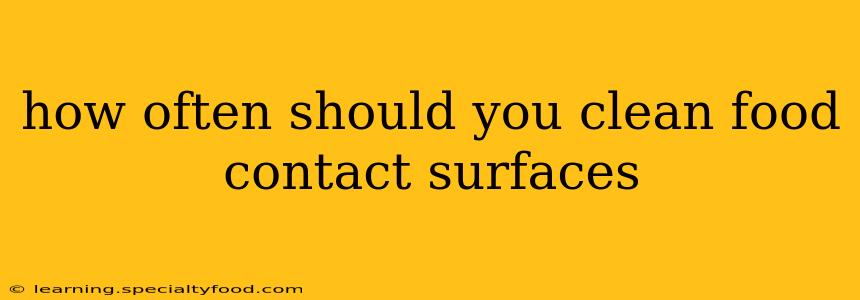Maintaining a clean kitchen is crucial for preventing foodborne illnesses and ensuring food safety. But how often should you actually clean food contact surfaces? The answer isn't a simple number, but rather a multifaceted approach based on frequency of use and the type of surface. Let's delve into the details.
What are Food Contact Surfaces?
Before we discuss cleaning frequency, let's clarify what constitutes a food contact surface. These are any surfaces that come into direct contact with food during preparation, processing, or storage. This includes:
- Cutting boards: Wooden, plastic, or other materials.
- Knives and utensils: Forks, spoons, spatulas, etc.
- Countertops: Granite, marble, stainless steel, laminate.
- Sinks: Especially important due to potential water contamination.
- Dishes and glassware: Plates, bowls, cups, etc.
- Food preparation equipment: Mixers, blenders, food processors.
How Often Should You Clean Food Contact Surfaces? A Practical Approach
There's no single "magic number" for cleaning frequency. Instead, think of it in terms of after each use and regular deep cleaning.
After Each Use: This is the most crucial aspect of food safety. Always clean and sanitize food contact surfaces immediately after using them, especially if they've been in contact with raw meat, poultry, seafood, or eggs. This prevents the spread of harmful bacteria and cross-contamination. A quick wash with hot, soapy water is usually sufficient, followed by a rinse. Sanitizing is highly recommended (more on this below).
Regular Deep Cleaning: In addition to cleaning after each use, you should also perform a more thorough cleaning of your food contact surfaces on a regular basis. This involves a more comprehensive cleaning process, possibly including scrubbing and disinfecting. The frequency of this deep cleaning depends on the surface and its usage:
- Daily: Countertops, sinks, and cutting boards should ideally undergo a deep clean at least daily, especially if used extensively.
- Weekly: Larger appliances like mixers and food processors should be thoroughly cleaned at least once a week.
- As needed: Other surfaces may require cleaning less frequently, depending on their usage.
What About Sanitizing?
Sanitizing is a crucial step in food safety, going beyond simple cleaning. Sanitizing reduces the number of microorganisms on surfaces to safe levels. You can sanitize using:
- Heat: Running surfaces through a dishwasher at a high temperature is an effective method.
- Chemical sanitizers: These are available in various forms and should be used according to the manufacturer's instructions. Always ensure proper ventilation when using chemical sanitizers.
How to Properly Clean Different Food Contact Surfaces
Different surfaces require different cleaning methods.
How Often Should You Clean a Cutting Board?
Wooden cutting boards require more frequent cleaning and oiling to maintain their integrity and prevent bacterial growth. Plastic cutting boards should be washed thoroughly and sanitized after each use.
How Often Should You Clean a Sink?
Sinks should be cleaned daily, as they accumulate food particles and bacteria. Pay special attention to the drain.
How Often Should You Clean Utensils?
Utensils should be washed and sanitized after each use, especially those used with raw meats.
How Often Should You Clean a Refrigerator?
Your refrigerator should be thoroughly cleaned at least once a month to remove spills and prevent bacterial growth.
What are the Consequences of Not Cleaning Food Contact Surfaces Frequently Enough?
Failing to clean food contact surfaces adequately can lead to serious consequences, including:
- Foodborne illnesses: Bacteria such as Salmonella, E. coli, and Listeria can easily contaminate food through unclean surfaces, leading to illnesses ranging from mild discomfort to severe, life-threatening conditions.
- Spoilage: Unclean surfaces can contribute to food spoilage, leading to wasted food and potential health risks.
- Pest infestation: Food particles left on surfaces can attract pests like cockroaches and ants, compromising food safety and hygiene.
Conclusion
Maintaining a high standard of cleanliness for food contact surfaces is paramount for food safety and preventing illnesses. While the frequency varies based on the type of surface and usage, the principle of cleaning after each use and regular deep cleaning remains essential. Prioritize sanitation to minimize bacterial contamination and create a safe cooking environment. Remember, prevention is always better than cure when it comes to food safety.
